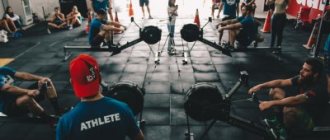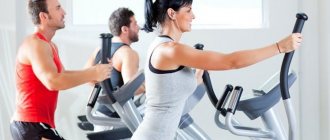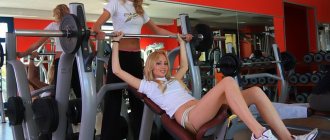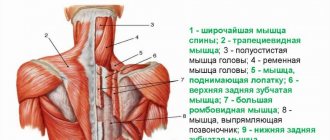What is cycling
Cycle training is a functional group cardio training that is performed on special stationary bicycles - spin bikes. It is an interval training using various equipment, working all muscle groups, including the heart.
Group training involves pedaling with varying resistance to rhythmic music, which is selected by the trainer depending on the required tempo of the load. The position of the torso changes when riding, as does the speed of rotation and the load on the legs.
Acceleration can be changed to force resistance, in which the leg muscles receive maximum load. Cardio can be alternated with exercises with dumbbells, body bars, balls for all muscle groups, and with your own body weight. The spinning training program is developed by the instructor.
What is cycle
Cycle training is one of the new concepts in fitness. Cycle - bicycle in English. In essence, this is a workout on an exercise bike.
So, if you go to the gym, you've probably seen people pedaling for an hour without doing any other exercise. A new type of training was discovered by American cyclist Johnny Goldberg. Recently, many people have been practicing his method.
The essence of the workout is to actively pedal for 30-40 minutes. In this case, the exerciser must change the load level of the exercise bike. If you are new to this business, then it is better to work out the first few lessons under the guidance of a trainer. He will explain how to properly perform each level of training. If this is not possible, then find a video on the Internet with detailed explanations of each stage of the lesson.
You must pedal the exercise bike while sitting or standing. Both positions should be changed alternately. Working out on a stationary bike is not like regular cycling. On it you simulate riding a racing bike, so you tilt your back towards the machine. During the first classes you will feel the muscles in your lower back tightening, but after a few classes this will go away.
Cycle aerobics is an energetic form of exercise. After it, the body will become fit and slender. During training, the load can be measured using:
- resistance level;
- pedaling speed;
- body position.
Pros and cons of cycling
Benefits of training:
- Cycling helps reduce body fat by providing oxygen and increasing heart rate.
- It tones all muscle groups, since the training is aimed not only at strengthening the muscles of the legs, but also the shoulder girdle and torso with the help of strength exercises.
- Trains the cardiorespiratory system, improving the functions of the respiratory organs, strengthening the heart and blood vessels, and normalizes blood pressure.
- The training does not load the joints and spine and does not increase compression on them, like strength exercises.
- Training is safe for any age, unless there are contraindications from the cardiovascular system.
- The duration of the exercise does not exceed 60 minutes; 2-3 classes per week are enough to get into good athletic shape.
- The training is carried out in an interesting way with trendy, energetic music.
Disadvantages of training:
- It does not allow you to increase muscle volume, compacting the muscles in length rather than width.
- Exercise is not allowed for diseases of the cardiovascular system, high blood pressure, tachycardia, or heart defects.
Training programs
All physical activities are performed according to certain rules, cycle training is no exception. Before you start pedaling, you need to warm up. This could be running on a treadmill or some kind of standing exercise. Warm-up is needed to warm up the joints. The fact is that intense pedaling can have a bad effect on knee joints that are not warmed up. After the warm-up, the main part of the training begins, reaching maximum load. After this, the intensity of the activity begins to decrease.
If you have never done cycling aerobics, then take a class for beginners first. This is the only way you can understand whether such loads are suitable for you and whether you can follow the trainer’s instructions. Very often, beginners do not stretch out the training and choose easier methods of training. If you liked everything, then after two weeks of classes you can start studying in the main group.
Pulse and heart rate monitor
It is important to understand that during any physical, and especially aerobic, exercise, a person’s heart beats more rapidly - 60-200 beats per minute. Heart rate Heart rate is also called pulse. And for each age, the maximum heart rate is different. A young athlete can pedal for a short period of time with a heart rate of 200, which is fatal for an older person. Therefore, monitoring your pulse is very important!
It is calculated using the formula - the number 220 subtract your age:
Heart ratemax= 220 – age
HRmax is the maximum possible heart rate for a certain age. Approximate heart ratemax for all ages is shown in the table below, as well as training zones:
Example. If you are 40 years old, your maximum heart rate is 180 beats per minute. Exceeding this threshold is dangerous for your health!
To monitor the load on your heart, buy a heart rate monitor with a chest sensor, for example, from Polar, Sigma, Garmin. It consists of a wristwatch with a display and a chest strap sensor. When the threshold is exceeded, it makes a beeping noise. Do not buy a heart rate monitor without a chest strap; these heart rate monitors have an optical sensor installed on the back of the watch. Its accuracy leaves much to be desired.
Photo above - Sigma PC 25.10 with chest sensor; photo below: heart rate monitor with optical sensor Mio Alpha 2.
Programs for exercise bike
Program No. 1 (entry level)
Classes 3-4 times a week, optimal training duration: 20-30 minutes, intensity: up to 65% of heart ratemax.
Program No. 2 (intermediate level)
Classes 3-5 times a week, optimal training duration: 20-45 minutes, intensity: 65-80% of heart ratemax.
Program No. 3 (interval training)
Examples of interval training are given below. At the highest possible pace, the pulse can reach 85-100% of HRmax.
Interval training:
- 5-10 minutes – warm up, pedal at a minimum pace;
- 30 seconds – medium pace, do not forget about breathing control, breathe through your nose;
- 30 seconds – maximum tempo;
- alternating average and maximum tempo several times;
- 10-15 minutes – cool down.
Interval training example 2:
- 5 minutes - calm average pace;
- 5 minutes - high pace, pedal quickly;
- 30-60 seconds - the maximum possible pace at the limit of capabilities.
Cycle workout for weight loss
Of course, home workouts will not allow you to plunge into the atmosphere of training in fitness clubs and get motivation from a trainer. After choosing a spin bike for your home, choose energetic tracks for training. Exercise no more than one hour 3 times a week; trained athletes can increase the number of workouts to four .
Complex without equipment
Warm-up at a calm pace is necessary to warm up the muscles and ligaments for 10 minutes. Then proceed to the main program.
- Rotate the pedals while standing - 1 minute.
- Rotate the pedals while standing with your palms resting on the front of the steering wheel – 1 minute.
- Rotate the pedals while standing with emphasis on your forearms – 1 minute.
- Acceleration while sitting at low resistance, holding the handles - 1 minute.
- Rotation at a calm pace - 1 minute.
- Maximum resistance, power pedaling – 1 minute.
- Rotation at a calm pace - 1 minute.
- Rotate the pedals while sitting with emphasis on your forearms at an average level of resistance – 1 minute.
- Acceleration in the same position with low resistance – 1 minute.
- Rotate the pedals at a calm pace – 1 minute.
Repeat the complex 3-4 circles.
After cardio, perform a bodyweight routine for 3 rounds.
- Push-ups from the floor or from the knees, 15-20 repetitions.
- Plank – 1 minute.
- Bicycle crunches - 30 times.
Stretching – 5 minutes.
Interval training with dumbbells
Warm up for 10 minutes – pedaling at medium speed.
- Rotate the pedals while standing with emphasis on your forearms – 1 minute.
- Standing dumbbell press – 20 times.
- Acceleration while sitting at low resistance, holding the handles - 1 minute.
- Dumbbell rows to the belt – 20 times.
- Maximum resistance, power pedaling – 1 minute.
- Elevated push-ups – 15-20 times.
- Rotate the pedals while sitting with emphasis on your forearms at an average level of resistance – 1 minute.
- Extension of a dumbbell with both hands from behind the head 15-20 times.
- Acceleration at low resistance, emphasis on forearms - 1 minute.
- Curling arms with dumbbells 15-20 times.
Repeat the complex for 3-4 circles, at the end stretch the muscles.
What muscles can you train with a bike?
Cycling is an excellent cardio exercise, a way to saturate muscles with oxygen, activate metabolism, and improve blood circulation. Exercise bike training is quite intense, it takes from 40 minutes to an hour, and is practiced 2 to 4 times a week. During one lesson, the pace of rotation of the pedals and the load change; they are performed not only in a sitting position, but also in a standing position, with a change in the position of the body.
Therefore, during training, the load is placed on many muscles:
1. Hips - biceps and quadriceps. They become tense during normal pedaling, toe lifting, riding in a seated position, and when a person sits up on a machine.
2. Caviar. They are directly involved in the movement, so they get a good workout when riding an exercise bike, regardless of the pace.
3. Arms – triceps and biceps. To ensure that they are also stressed, special exercises are performed during training.
4. Belly. If you pedal while sitting, the main emphasis is on the lower abdomen. If you include standing riding in your classes, the upper muscles are activated. So, with the help of a cycle, it is quite possible to make your stomach flat.
5. Necks, forearms. If you hold your neck correctly - freely, without straining or rounding your back, then training will have a positive effect on this part of the body.
6. Buttocks. These muscles are very well worked out during training, since they are involved in all movements on the exercise bike.
Of the listed groups, the muscles of the buttocks, abdomen and legs work the most - the most problematic female areas, which often suffer from deposits of fat reserves. This is why cycling is so popular among those who want to lose weight and give their figure beautiful shape, because during this class all those parts of the body that need correction are simultaneously worked out.
The best machines for cycling
- DOMYOS - a manufacturer produces a line of spin bikes for home workouts costing from 15,000 rubles. The bikes are comfortable to use, hold a stable position, and it is also possible to adjust the position of the handlebars and saddle.
- DFC - spin bikes from China for home use belong to the budget segment, their cost starts from 11,000 rubles. The seats are adjustable horizontally and vertically. They include heart rate sensors and a display on which the pulse is displayed.
- Star Trac is a brand from the USA that produces high-quality professional spin bikes that can also be used for home exercises. The line is popular among modern fitness clubs. The cost of goods is over 100,000 rubles.
- LIFE FITNESS is a manufacturer that produces spin bikes for home and professional use using the latest technologies. The price for spin bikes starts from 137 thousand rubles.
- PRECOR is a line of home and professional spin bikes that provide comfort and safety for training at any level of physical fitness, taking into account the morphological characteristics of a person. Prices are over 140 thousand rubles.
How to exercise correctly - 5 nuances
Each workout requires adherence to technique and certain standards. The same applies to cycling aerobics, which should not be confused with simple cycling exercises. Of course, there are parts in common with simple exercise bikes and the use of a bicycle, but there are different features to consider.
Competent technology
Before starting a cycle lesson, you will need to set up the simulator, for this it is best to use the assistance of instructions or a trainer, from the main points we note:
- when the pedal is in the lower position, the leg remains slightly bent, but practically straightened;
- steering wheel and seat are almost at the same level;
- the distance from the steering wheel to the seat is equal to the length of your elbow , you need to determine the distance so that your back is not bent and there is no need to stretch out excessively, the body is almost exactly along the ground.
Beginners can place the handlebars slightly higher than the seat to take the strain off their back. To understand the correct technique, you can watch how professional cyclists sit at races. We examined in detail the nuances of proper seating on various types of exercise bikes.
Features of body position:
- the back is straight, the shoulder blades are almost brought together;
- the shoulders are slightly pulled down, the neck is not overstrained and free;
- the buttocks do not move forward and remain above the large part of the seat;
- the feet look forward, do not bend down, the toes do not overexert;
- Elbows point down, hands rest on the steering wheel.
What not to do:
- bounce - stay in the saddle tightly, in order to help yourself, you can even imagine how someone is pressing on your shoulders, you only need to rotate your legs, do not push on top while jumping;
- round your back – you also don’t need to bend your lower back excessively; your body ideally becomes almost straight from the tailbone to the chin;
- overload yourself – you need to train intensely, but when you need to sit down and rest, do a little sitting;
- arch your feet - keep your feet level with the floor, and to take the stress off your quads and add a little more training to your hamstrings, lift your heel a little higher than your toes, which you can do by imagining it's like you're pulling up on the pedals, but don't push down on the pedals.
Where to start first?
Training should not begin with fatigue; even experienced athletes use this technique separately on a certain day and no longer apply significant loads.
In addition, it is advisable to eat some healthy carbohydrates an hour or two before training. Many people start their workout with a warm-up , and this makes sense, even if the training program includes a warm-up ride.
Also, before training, you should configure the simulator to your own parameters. Only after this you can start the lesson.
What heart rate is acceptable during exercise?
For each, this parameter is determined individually. You need to take your age and subtract this number from 220, for example, if you are 25 years old, then 220-25=195. This is your maximum allowable heart rate, but you should not reach this value during training; on the contrary, it is better to avoid this value.
The training heart rate range is defined as a percentage of the maximum. Typically, the following ranges are distinguished:
- 50-60% - warm-up;
- 60-70% – fat burning;
- 70-80% - body training;
- 80-90% - increase in the range of endurance and other parameters.
Sometimes these values are shifted by 5%, that is, the maximum becomes 95%.
One way or another, in the limit zone, which is used to increase the limits of your body, you train for no more than 5 minutes during training, during the rest of the period you work in the range of 60-80% of the maximum, depending on the goal. Therefore, let’s take the maximum allowable heart rate as 95%, in our example, this frequency is considered as 220-25 * 0.95 = 185, you should work at this heart rate for no more than five minutes, and reduce the intensity. Attention! The bike trainer uses an on-board computer that can help you determine your target heart rate zones. Typically, they are highlighted in colors, but you also need to pay attention to the actual data (heart rate monitor) and not just the advice that the computer gives.
How long should the workout be?
The duration of the workout is also a variable parameter. How much should you study? Beginners train for half an hour, lasting about 45 minutes, and experienced athletes can train for up to an hour.
Much also depends on the intensity of the training and the goals that you set at this stage.
Sample program
A simple workout program looks something like this:
| Duration | Content |
| 3-5 minutes | Warm up, light load. |
| 10-12 minutes | Riding in a standing position with alternating load changes from medium to heavy. |
| 10-12 minutes | Interval training, simulating descents and ascents, riding in a standing and sitting position. |
| 5-7 minutes | Riding using additional exercises, push-ups from the steering wheel, riding with pelvic abduction and the like, depending on the program. |
| 10-12 minutes | Simulation of driving on the highway, cycles of acceleration and deceleration. |
| 3-5 minutes | Cool down, easy ride. |
| 5 minutes | Stretching exercises (optional). |
This program is the most basic option. As a rule, group classes are much more varied and include many interesting elements, thanks to which cycling perfectly pumps up the body completely.
How often should you do cycling?
Since training on exercise bikes is most often done in groups, you should definitely focus on the schedule of classes at the gym.
But the ideal option is to exercise 3-4 times a week, especially if your goal is to lose weight. In this case, within a month you will notice qualitative changes in your body. If your primary goal is to strengthen your muscles, then 2-3 sessions per week will be enough. Remember that cycling is an aerobic workout, plan your load based on these considerations.
If your fitness club offers several levels of programs for beginners or advanced participants, then start with the simpler one. As you develop stamina, you will be able to advance to the next level. But even if the groups are not divided depending on physical fitness, that’s okay. You can adjust the load yourself by decreasing or increasing resistance or speed.
Tips for cycling:
- Do not eat two hours before training and about an hour after it. This will give the body the opportunity to actively burn fat.
- During and after training, you need to drink clean, still water - it will help replenish fluid loss.
- The correct frequency of exercise is 3-4 times a week, no more, because the muscles need to be given time to recover.
Pros of cycling aerobics:
- Cycle is one of the most intense aerobic programs; in just one workout you burn 500-600 calories.
- You can independently adjust the load, increasing resistance and riding speed.
- Spinning is interval training, and this is the most effective way to burn excess fat.
- You train the cardiovascular system and develop your endurance.
- Cycle will not give you the opportunity to skid and avoid loads. Get ready to give it your all.
- This type of fitness is suitable for both men and women.
- Spinning is also suitable for those who do strength training. This cycling workout will improve blood circulation, which means that blood and oxygen will flow faster to the muscles and accelerate their growth.
- Cycle aerobics is more effective at burning calories than classic exercise on a treadmill, elliptical or exercise bike.
We also include the opportunity to meet new friends in group classes as an advantage. Before you know it, a secret club of interests will form among the training participants.
If you want to have a closer friend among like-minded people, find him in advance. To do this you need to create your profile
on the
invme
, and then publish
your event in the announcements feed.
It is enough to indicate your offer and place your photo. In the vastness of our service, people often find travel companions, partners for going to the gym and, of course, soul mates. Therefore, you can be sure that it will not be difficult for you to find someone here to attend cycle training together.
Disadvantages of cycling aerobics:
- Cycle is considered an extreme type of group training, so beginners in fitness are not recommended to do it.
- The program puts a serious load on the knee joints, so they can cause pain during prolonged exercise.
- After the first two or three workouts on a static bike, your buttocks may become very sore from the unusually hard seat.
- Before spinning, it is better to consult a doctor, especially if you have heart problems or varicose veins.
Sample program
Consider a small program that will allow you to effectively train for weight loss:
| Duration of the stage | Content |
| 5-7 minutes | Warm up, easy ride. |
| 2 minutes | Driving while standing with emphasis on the upper part of the steering wheel. |
| 2 minutes | Riding while standing with slow push-ups from the steering wheel. |
| 2 minutes | Riding while standing with the pelvis abducted, the sit bones hanging over the rear edge of the seat. |
| 2 minutes | Riding while standing, the position is identical to the previous one, the body is tilted towards the steering wheel and back, the pelvis practically does not move and remains above the seat. |
| 2 minutes | Riding while standing, arms are alternately pulled back, bent at the elbow, the body turns slightly in the direction of abduction of the arm. |
| 10-12 minutes | Riding while sitting, increasing the load every 2-3 minutes, intense rotation. |
| 10 minutes | Continue with 2 minute exercises. |
| 5 minutes | Imitation of climbing uphill with increasing load, alternating standing and sitting positions. |
| 5-7 + 7 minutes | Cool down on the machine + stretching after training. |
The load here should be selected individually. Focus on your heart rate, do not go beyond 80% and do not reduce your heart rate to less than 60% of the maximum .
To perform stretching exercises, you can remain on the machine (for example, you can put your feet on the steering wheel and bend forward).
While sitting, you can also do leg flexions and abductions. Of course, after this it is useful to perform stretching exercises on the floor.
What is it and who is it suitable for?
Cycling is training on exercise bikes. But this is not just a monotonous ride, the pace should change, simulating real races on mountains and slopes. The discoverer was the American John Goldberg, who invented the exercise bike and the training program on it.
Model Candice Swanepoel lost weight after her first pregnancy with the help of cycling, since intense training was contraindicated for her after giving birth. Ariana Grande also loves cycling because this type of cardio helps her legs stay slim, toned, without an ounce of cellulite, and her butt becomes rounder, which is a dream for a skinny girl of her build.
This sport is suitable for all those who do not like active sports, as well as those for whom exercises with a load on the back are contraindicated. After all, when cycling, there is practically no load on the back and lower back.
But training on exercise bikes is contraindicated if:
- bronchial asthma;
- phlebitis and thrombophlebitis;
- oncological diseases
; - diabetes mellitus;
- diseases of the cardiovascular system;
- obesity and excessive body weight;
- diseases of the musculoskeletal system.
The benefits and harms of cycling aerobics
Let's look at the pros and cons of cycling. I consider the clear advantages:
- Fascinating and fun group activities accompanied by rhythmic music.
- High intensity.
- Increased calorie expenditure during cycling training.
- All muscle groups are involved (especially legs, buttocks, back and abs).
- Development of endurance.
- The best way to eliminate cellulite.
Cycle aerobics has much fewer disadvantages, but the main disadvantage is the high requirements for admission to classes. Naturally, there are clubs where everyone who has paid for a subscription is invited to training, but I do not recommend visiting such establishments. The potential damage from this approach to cycling may significantly outweigh the benefits.
The second disadvantage is dependence on the coach. Unlike fitness, where the instructor may not influence the training process in any way, in cycling the movements of the trainer are completely copied. As in any type of aerobics, it sets the rhythm, degree of load, movement and determines the technique for exercises or entire series. A cycling coach must understand the specifics of the group, the level of physical fitness, and preferably have a medical or sports education. This is especially important for the “risk group” in cycling, that is, people with medical contraindications.
Energy costs
Calorie expenditure greatly depends on the type of cycling, the group and the trainer. Also, this indicator is directly affected by the duration of classes. On average, if you take into account a session of 60 minutes, athletes can lose from 600 to 1200 kcal. 600 is the minimum value that is often reached in beginner groups. More experienced groups, especially when adding additional movements or series of plyometric exercises, can spend 1000-1200 kcal in one cycle workout for 60 minutes of constant load. We are talking about athletes who can endure an hour-long cycling session almost without a break. In addition to experience in cycling, such athletes should not have any health problems or contraindications.
How to make your training more effective
To make your training more effective, you need to follow some rules.
Don't eat an hour and a half before training
Starting a workout on a full stomach is not the best idea; it is better to have a snack a few hours before class. Then you will have enough energy to perform the exercises and there will be no discomfort.
Drink water during training
Your workout will be more effective if you drink small sips of water during your workout. It is important to do this not only during training, but also before and after it. Water will help the body cope with such high loads more easily.
Train regularly
It is important to follow a training schedule; two or three sessions a week will be enough to keep your body in shape.
Don't exercise two hours before bedtime
Cycling is an intense type of exercise, so it is better to do it during the day. It all depends on your daily routine: you can train both in the first and second half of the day. But it's better to do this a few hours before bedtime.
Work out with a trainer
If you come to cycling for the first time, be sure to take a trainer. He will point out possible errors, help set up the simulator, and select the desired intensity. Also, supervised exercise will help make your workout more effective.
Everything you need to know about this type of training
Now we know what this type of training on an exercise bike is called, then we will give a more detailed description of the nuances. This type of sports exercise is carried out in gyms that are equipped with special exercise bikes. The training simulates the process of a bicycle race, led by an instructor. It sets the pace and creates a spirit of unity in achieving the goal.
Advantages and disadvantages
This type of training has its positive and negative sides.
The advantages are:
- Maintaining good physical shape - exercises perfectly work out the main muscle groups.
- The ability to burn a large number of calories - intense exercise allows you to get rid of extra pounds much faster than with regular training.
- Getting rid of extra pounds - cycling is an excellent prevention of excess weight.
- Development and strengthening of joints - for healthy joints such loads are useful, as they prevent their diseases.
- Training the respiratory system , increasing lung capacity - developing endurance helps prevent various diseases.
- Strengthening the heart muscle and blood vessels makes it possible to keep the heart healthy and blood vessels elastic.
- Improving blood circulation - prevents congestion in the lower extremities, is a prevention of varicose veins.
- Accelerating metabolism - helps you lose extra pounds faster.
- Getting rid of stress and depression - active exercise promotes the production of joy hormones - endorphins.
The disadvantages are:
- High intensity classes are not suitable for beginners , as they require a preliminary level of physical fitness.
- Those who are not recommended to exercise heavily on the cardiovascular system , muscles and joints should not exercise.
- The availability of this type of activity is only for physically developed people , since spinning training is an extreme type of load.
5 useful properties of such activities
Cycling belongs to the category of high-intensity loads. It is suitable for those who want to maintain good physical shape and for those who are concerned about the problem of excess weight. Its benefits are undoubted and are as follows:
- During classes, the work of the body’s cardiac, vascular and respiratory systems is activated, muscles are strengthened, and joints are developed.
- Such active muscle work has a positive effect on the nervous system.
- Along with calories, negative emotions “burn out”, stress resistance increases, and a person is charged with a good mood.
- These classes are ideal for group training, which further increases motivation.
- Psychologists recommend that organizational leaders use cycling as part of their training for their employees. These classes help to unite the team, get rid of accumulated negative emotions and disagreements in the work group.
For the benefits and contraindications of cycling, see a separate article.
What you need for classes
Cycling is one of those sports for which equipment is very important. First of all, you need to choose a comfortable uniform; it should be clothing made of water-repellent materials. You should also definitely choose special cycling shorts, they are more comfortable to exercise in. For exercise, it is advisable to purchase cycling gloves to prevent your hands from slipping.
Before the lesson, you will be given special shoes with hard soles; your feet should be in a stable position on the pedal and not slip.
Indications and contraindications
The list of indications for cycling is quite long. Given the incredible effectiveness and high variability of exercise intensity, cycling is recommended for almost all people. Among the main indications it is worth highlighting:
- Weight correction (both in the medical treatment of obesity and for losing weight before the summer season).
- Development of the cardiovascular system.
- Increasing strength and aerobic endurance.
- Development of the respiratory system.
- Strengthening the immune system.
- Improved muscle tone.
Cycling is more effective than running, rowing and other types of cardio. But for such pronounced advantages you have to pay with high requirements and entry barriers. Due to super-intense and fairly heavy loads, cycling training is contraindicated:
- For arthrosis of the knee joints.
- For low or high blood pressure.
- For varicose veins.
- Hypertensive patients.
- People with chronic diseases.
In some cases, special groups are created where people with contraindications to cycling are admitted. But this requires a lot of experience from the coach and moderate loads, taking into account the health status of the athletes. Also, men with chronic prostatitis should give preference to the standing technique in cycling, avoiding prolonged sitting.










